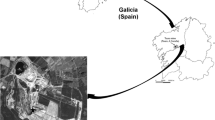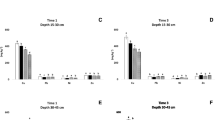Abstract
One of the most important sources of pollution caused by metals, if not the most important, is mining. Metal pollution is covert, persistent and irreversible. For this reason, soil metal pollution has become a severe problem in many parts of the world. The aim of this study was to observe which combination of amendments (compost + biochar or technosol + biochar) combined with Brassica juncea L. was best at reducing the assimilable contents of Cu, and which also increased to a lesser extent the contents of other metals (Ni, Pb, Zn) found in these amendments. We also studied the phytoremediation capacity of brassicas in these amendments. The experiment was carried out using 45-cm-deep cylinders over and 11-month period, with soil from the settling pond in the depleted copper mine located in Touro (Galicia, north-west Spain). At depth 0–15 cm, the settling pond soil (S) had a higher CaCl2-extractable Cu, Pb, and Ni concentration, at the three time periods measured (time 1 = 3 months, time 2 = 7 months, time 3 = 11 months). The settling pond soil + technosol + biochar and vegetated with Brassica juncea L. (STBP) had the highest CaCl2-extractable concentrations of Zn over time. In general terms, the most effective treatment for reducing the phytoavailable contents of Cu, Pb, Ni and Zn was the treatment using compost +b iochar + Brassica juncea L. In the two treatments applied, Brassica juncea L. had a good phytostabilisation capacity.




Similar content being viewed by others
References
Alvarenga P, Farto M, Mourinha C, Palma P (2016) Beneficial use of dewatered and composted sewage sludge as soil amendments: behaviour of metals in soils and their uptake by plants. Waste Biomass Valor 7:1189–1201
AEMET (2015) Valores Climatológicos Normales. Santiago de Compostela Aeropuerto. http://www.aemet.es/es/serviciosclimaticos/datosclimatologicos/valoresclimatologicos?l=1428&k=gal
Baker AJM, Brooks RR (1989) Terrestrial higher plants which hyperaccumulate metallic elements: a review of their distribution, ecology and phytochemistry. Biorecovery 1:81–126
Beesley L, Marmiroli M (2011) The immobilisation and retention of soluble arsenic, cadmium and zinc by biochar. Environ Pollut 159:474–480
Beesley L, Inneh OS, Norton GJ, Moreno-Jimenez E, Pardo T, Clemente R, Dawson JJC (2014) Assessing the influence of compost and biochar amendments on the mobility and toxicity of metals and arsenic in a naturally contaminated mine soil. Environ Pollut 186:195–202
Bernal MP, Clemente R, Walker DJ (2007) The role of organic amendments in the bioremediation of heavy metal-polluted soils. In: Gore RW (ed) Environmental research at the leading edge. Nova Pub, New York, p 1e57
Busuioc G, Elekes CC, Stihi C, Iordache S, Ciulei SC (2011) The bioaccumulation and translocation of Fe, Zn, and Cu in species of mushrooms from Russula genus. Environ Sci Pollut Res 18:890–896
Cui H, Fan Y, Fang G, Zhang H, Su B, Zhou J (2016) Leachability, availability and bioaccessibility of Cu and Cd in a contaminated soil treated with apatite, lime and charcoal: a five-year field experiment. Ecotox Environ Safe 134:148–155
FAO (2006) World Reference Base Soil Resources. IUSS, ISRIC, FAO, Roma
Fellet G, Marmiroli M, Marchiol L (2014) Elements uptake by metal accumulator species grown on mine tailings amended with three types of biochar. Sci Total Environ 468–469:598–608
Forján R, Asensio V, Rodríguez- Vila A, Covelo EF (2016) Contributions of a compost-biochar mixture to the metal sorption capacity of a mine tailing. Environ Sci Pollut Res 23:2595–2602
Fowles M (2007) Black carbon sequestration as an alternative to bioenergy. Biomass Bioenergy 31:426–432
Gomes P, Valente T, Sequeira MA, Grande JA, de la Torre ML (2016) Enrichment of trace elements in the clay size fraction of mining soils. Environ Sci Pollut Res 23:6039–6045
González-González A, Cuadros F, Ruiz-Celma A, López-Rodríguez F (2013) Energy-environmental benefits and economic feasibility of anaerobic codigestion of Iberian pig slaughterhouse and tomato industry wastes in Extremadura (Spain). Bioresour Technol 36:109–116
Gusiatin ZM, Kurkowsk R, Brym S, Wiśniewski D (2016) Properties of biochars from conventional and alternative feedstocks and their suitability for metal immobilization in industrial soil. Environ Sci Pollut Res 23:21249–21261
Hendershot WH, Duquett M (1986) A simple barium chloride method for determining cation exchange capacity and exchangeable cations. Soil Sci Soc Am J 50:605–608
Houba VJG, Temminghoff EJM, Gaikhorst GA, Van Vark W (2000) Soil analysis procedures using 0.01 M calcium chloride as extraction reagent. Commun Soil Sci Plant Ana 3:1299–1396
Karami N, Clemente R, Moreno-Jiménez E, Leppd NW, Beesley L (2011) Efficiency of green waste compost and biochar soil amendments for reducing lead and copper mobility and uptake to ryegrass. J. Hazard Mater 191:41–48
Karer J, Wawra A, Zehetner F, Dunst G, Wagner M, Pavel PB, Puschenreiter M, Friesl-Hanl W, Soja G (2015) Effects of biochars and compost mixtures and inorganic additives on immobilisation of heavy metals in contaminated soils. Water Air Soil Pollut 226:342
Kidd P, Barceló J, Bernal MP, Navari-Izzo F, Poschenriederb C, Shileve S, Clemente R, Monterroso C (2009) Trace element behaviour at the root–soil interface: implications in phytoremediation. Environ Exp Bot 67:243–259
Li Z, Ma Z, van der Kuijp TJ, Yuan Z, Huang L (2014) A review of soil heavy metal pollution from mines in China: pollution and health risk assessment. Sci Total Environ 468–469:843–853
Macía P, Fernández-Costas C, Rodríguez E, Sieiro P, Pazos M, Sanromán MA (2014) Technosols as a novel valorization strategy for an ecological management of dredged marine sediments. Ecol Eng 67:182–189
Macías Vázquez F, Calvo de Anta R (2009) Niveles genéricos de referencia de metales pesados y otros elementos traza en los suelos de Galicia. Xunta de Galicia, Santiago de Compostela
Nouri M, Haddioui A (2016) Human and animal health risk assessment of metal contamination in soil and plants from Ait Ammar abandoned iron mine. Morocco Environ Monit Assess 188:6
Ohsowski BM, Klironomos JN, Dunfield KE, Hart MM (2012) The potential of soil amendments for restoring severely disturbed grasslands. Appl. Soil Ecol 60:77–83
Peijnenburg WJG, Jager T (2003) Monitoring approaches to assess bioaccessibility and bioavailability of metals: matrix issues. Ecotox Environ Safe 56:63–77
Perez-Esteban J, Escolastico C, Masaguer A, Moliner A (2012) Effects of sheep and horse manure and pine bark amendments on metal distribution and chemical properties of contaminated mine soils. Eur. J Soil Sci 63:733–742
Pérez-Esteban J, Escolástico C, Moliner A, Masaguer A, Ruiz-Fernández J (2014) Phytostabilisation of metals in mine soils using Brassica juncea in combination with organic amendments. Plant Soil 377:97–109
Pinto AP, Varennes A, Fonseca R, Martins-Teixeira D (2015) Phytoremediation of soils contaminated with heavy metals: techniques and strategies. AA Ansari et al. (eds) Phytoremediation: management of environmental contaminants. Volume 1. Springer International Publishing Switzerland. DOI https://doi.org/10.1007/978-3-319-10395-2_10
Porta J (1986) Técnicas y Experimentos de Edafología. Collegi Oficial D’enginyers Agronoms de Catalunya, Barcelona
Prapagdee S, Piyatiratitivorakul S, Petsom A, Tawinteung N (2014) Application of biochar for enhancing cadmium and zinc phytostabilisation in Vigna radiata L. cultivation. Water Air Soil Pollut 225:2233
Puga A, Abreu CA, Melo LCA, Paz-Ferreiro J, Beesley L (2015) Cadmium, lead, and zinc mobility and plant uptake in a mine soil amended with sugarcane straw biochar. Environ Sci Pollut Res 22:17606–17614
Rodríguez-Vila A, Covelo E, Forján R, Asensio V (2014) Phytoremediating a copper mine soil with Brassica juncea L. compost and biochar. Environ Sci Pollut Res 21:11293–11304
Rorat A, Suleiman H, Grobelak A, Grosser A, Kacprzak M, Płytycz B, Vandenbulcke F (2016) Interactions between sewage sludge-amended soil and earthworms—comparison between Eisenia fetida and Eisenia andrei composting species. Environ Sci Pollut Res 23:3026–3035
Santos ES, Abreu MM, Macías F, de Varennes A (2014) Improvement of chemical and biological properties of gossan mine wastes following application of amendments and growth of Cistus ladanifer L. J Geochem Explor 147:173–181
Solgi E, Esmaili-Sari A, Riyahi-Bakhtiari A, Hadipour M (2012) Soil contamination of metals in the three industrial estates, Arak, Iran. Bull Environ Contam Toxicol 88:634–638
Tai Y, Li Z, Mcbride M (2016) Natural attenuation of toxic metal phytoavailability in 35-year-old sewage sludge-amended soil. Environ Monit Assess 188:241
Violante A, Cozzolino V, Perelomov L, Caporale AG, Pigna M (2010) Mobility and bioavailability of heavy metals and metalloids in soil environments. J Soil Sci Plant Nutr 3:268–292
Wang QR, Dong Y, Cui Y, Liu X (2001) Instances of soil and crop heavy metal contamination in China. Soil Sediment Contam 10:497–510
Yao FX, Macías F, Virgel S, Blanco F, Jiang X, Camps-Arbestain M (2009) Chemical changes in heavy metals in the leachates from technosols. Chemosphere 77:29–35
Author information
Authors and Affiliations
Corresponding author
Additional information
Responsible editor: Philippe Garrigues
Rights and permissions
About this article
Cite this article
Forján, R., Rodríguez-Vila, A. & Covelo, E.F. Using compost and technosol combined with biochar and Brassica juncea L. to decrease the bioavailable metal concentration in soil from a copper mine settling pond. Environ Sci Pollut Res 25, 1294–1305 (2018). https://doi.org/10.1007/s11356-017-0559-0
Received:
Accepted:
Published:
Issue Date:
DOI: https://doi.org/10.1007/s11356-017-0559-0




